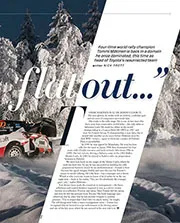

"We have to go absolutely flat out..."
Four-time world rally champion Tommi Mäkinen is back in a domain he once dominated, this time as head of Toyota’s resurrected team Tommi Mäkinen is 52. He doesn’t look it. His…
SPORTING MACHINES ON TEST.
THE 172 c.c. COVENTRY EAGLE MODEL D25. BY RODNEY L. WALK ERLEY.
AMONG the most interesting and novel machines at the Show was the Coventry Eagle miniature, which embodied a pressed steel frame—a construction rare in this country, but which has been experimented with on the Continent for many years.
It was with great pleasure, therefore, that I undertook the road-test of the D25 Model de luxe, which is equipped with the well-known 172 c.c. Super Sports type Villiers two-stroke engine, three speed Albion gear-box —giving ratios of 6-1, II-I and r9-I-7-Terry saddle and 26 in. X 2/ in. Dunlop cords, on 26 in. wheels. Certainly the appearance of the little machine is sufficiently attractive, and the welded steel tank, large
enough to hold two gallons, is finished most impressively in black, with a carmine nose.
Astride the machine I was impressed immediately with its feeling of ” bigness.” There is absolutely no impression of being mounted on a miniature, and the riding position accommodated my six feet three with ease and comfort, despite the fixed foot-rests and saddle position.
The Coventry Eagle was just off the train, so I was pleasantly surprised to find that, after filling up with petrol, the engine burst into life at the first gentle depression of the kick-starter. Buzzing along through London traffic towards the open country, I at once made up my mind that I liked the Coventry Eagle it was, indeed, a delight to handle,
steering with. certainty and devoid of that disconcerting lightness often experienced with miniature motorcycles. I was a little worried for the first mile or two by the large movement of the gear lever from notch to notch, as there appeared to be inches between top and middle, and m ddle and bottom. Actually, changing between top and middle is easily effected by one’s foot.
Once out on the open road an easy cruising speed of thirty-five miles perhour could be maintained indefinitely, but it seemed to me that a If gher average speed would be easily possible if close ratio gears were fitted. The ratios are much too wide for ordinary sporting purposes.
Nineteen to one seems unnecessarily low, as the 172 c.c engine has ample power to pull a much high bottom gear up any ordinary gradient, likely to be met with in the usual club trial. On the road, top gear is quite adequate for such hills as Brockley (Middlesex) and Holywell Hill, St. Albans. For the needs of the sporting rider, I should suggest that ratios of 6-1, 9-1, and 14-1 would be quite adequate.
On the main road I found the steering to be all that my first impressions promised. It was possible to steer hands off at any speed, and if the footrests were placed higher the most fantastic feats of cornering could be performed. As it is, the angle at which the machine can be banked is limited only by the footrests striking the ground.
Excellent Steering.
Not only is the machine stable laterally, but there is an entire absence of fore and aft bounce, and an application of the rear brake does not result in a locked wheel and a ” hopping ” movement along the road, so common in modern low-saddle position design.
The 1928 Villiers engine seems to be even better than last year’s specimens, and although driven fast with much usage of the gear-box, there was no tendency to seize, nor did the plug suffer from pre-ignition. This excellent state of affairs is without doubt due to the system of pressure lubrication, which is quite automatic in its functioning.
The supply of oil to the engine is regulated by an adjustable needle and a sight feed, which last, however, is not to show the rate of supply, but rather that the oil system is working satisfactorily. The system is simplicity itself. The oil tank being air-tight, the filler cap must be tightly screwed home ; the engine pressure, conducted by a pipe to the tank, forces oil via another pipe to the ctank case and bearings. The supply thus automatically varies with the speed of the engine and is perfectly satisfactory in use.
As it stood, I should estimate the machine could ‘better fifty for short periods, when a tinkling in the cylinder suggests an easing up, although thirty-five to forty miles an hour is an effortless cruising speed.
It is over rough-stuff and the colonial sections of a sporting trial that the full fascination and delight of the Coventry Eagle is to be felt, for where a heavier machine flounders hub-deep in the mud, the Coventry Eagle can be driven through, or at the worst, pushed with no great expenditure of energy.
On the Trials Course.
I took the machine over such a course during the road-test, and I was delighted with the ease of handling, and the steady steering over the worst of bumps and the slimiest of mud. Some parts of the course were baked hard, and the machine underwent a tremendous buffeting, but at the conclusion of the eighty-miles course nothing had broken, nothing had fallen off and the engine was as healthy as ever, despite the miles of middle and bottom gear work inevitable in a course of this nature.
The only fault I have to find with the machine is the situation of the brake pedal, and the using of a single bar running right through the frame for the footrests, upon which the brake pedal is mounted.
The rests became bent during the trial, caused by hitting them on corners and against petrified ruts. The result was that they became loose, and turned round and round in the frame, while the brake pedal naturally became inoperative.
The attention of the manufacturers might well be directed to this point, which detracts from an otherwise excellent production. The only other point worthy .of criticism is the position of the tool-case, which, as will be seen from the illustration, is tucked away, very neatly, under the tank, behind the engine, just over the gear-box. Although
this position has much to recommend it on the score of neatness, it is exquisitely inaccessible, and conducive to shortness of temper, accompanied by bad language.
The brakes, of the internal expanding type, are six inches in diameter, and quite up to the’r work, the front brake being especially noteworthy in this respect.
I did not accurately ascertain the rate of fuel consumption, it being the usual procedure to pour half-agallon into the tank every fortnight or so. The consumption seems to be well in excess of zoo m.p.g., and oil was used in the same proportion.
Without doubt, the Coventry Eagle Villiers is one of the best designs embodying this well-known power unit, and should have an instant appeal to the sporting rider, and the clubman, whose delight is the roughstuff trial.
The makers of this fascinating mount are the Coventry Eagle Cycle and Motor Co., Ltd., Bishopsgate Green Works, Foleshill Road, Coventry, and the price complete with electric lighting set is 1,37 ios., the tax being 30s.